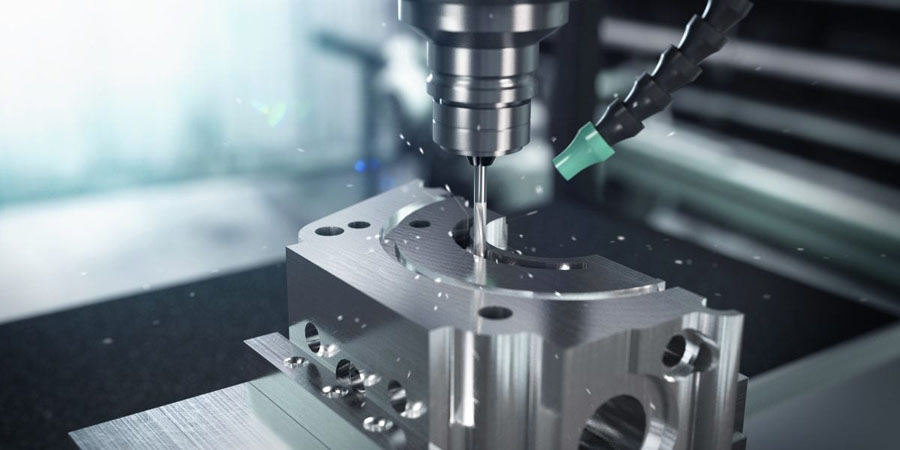By 2021, the unprecedented situation has greatly accelerated the technological innovation and progress of the CNC industry. Thanks to the focus on automation, waste reduction, global competition and the latest emerging technologies, a series of exciting trends and innovations will be brought about, which will further change the face of the CNC industry. In today’s manufacturing industry, the demand for technology continues to grow to meet the ever-increasing demand for productivity. Computer numerical control (CNC) machining can help companies around the world achieve their manufacturing goals by improving precision, accuracy and speed.
This article discusses the role and advantages of CNC machining technology in manufacturing.
CNC Technology In Modern Manufacturing
Modern CNC machine tools use a CNC program to sequentially remove raw materials from the workpiece, which is programmed to guide the machining process.
In contrast to “old-fashioned” equipment that is manually controlled via a hand wheel or joystick, CNC machines are operated by a computer executing a pre-programmed sequence of controlled commands. These fully automatic machines understand a dedicated CNC machining language called G code, which conveys accurate production measurements, including feed rate, speed, position, and coordination. Since the mechanical dimensions of parts are defined using computer-aided design (CAD) software, and then converted into manufacturing instructions through computer-aided manufacturing (CAM) software, there must be proficient CNC mechanics, operators and programmers in the process.
Manufacturers use software and machines (including milling machines, lathes, and grinders) to improve their performance. Modern computer-controlled machine tools with multi-axis machining capabilities use powerful software to create parts with geometric complexity and strict tolerance requirements.

How Does CNC Technology Benefit Manufacturing?
Compared with manual processing, CNC technology has a wide range of advantages. Automation technology minimizes human interference during operation, and has a high degree of repeatability and flexibility, thereby enabling manufacturers to enhance parameters such as accuracy, quality, productivity, and cost-effectiveness.
Improve Efficiency
CNC machines can be almost fully automated, so high-quality precision parts can be produced. CAM software generates code for the machine based on the CAD model, and the operator can program many machines to run simultaneously. When responding to market demands, digital processes provide reliable repeatability, improved tolerances, and seamless scalability. By definition, subtractive manufacturing will produce waste, but the high accuracy of CNC machine tools can minimize waste. Since this is a physical process, the waste is easy to recycle.
In addition, CNC machines can run for longer periods of time independently of manual intervention, without the risk of human error. The 3-axis and 5-axis machining capabilities enable CNC milling tolerances to +/- 0.01 inches for parts with complex geometries, and CNC turning tolerances to +/- 0.0005 inches. The typical lead time for manufacturing complex parts using 5-axis CNC machines may be 5 to 6 weeks, while the machining of simple parts can take several hours.
By improving speed, accuracy and quality, CNC machine tools can increase the efficiency of the entire machining process.
Productivity Increase
A CNC machine can perform multiple operations and process multiple tools at the same time. By combining multiple steps of manufacturing parts, CNC machine tools can significantly reduce cycle time. The reduced cycle time during rapid prototyping becomes an advantage. A CNC machine can produce a prototype that can be put into production multiple times in just a few hours. Once the prototype is ready for production, these machines can easily repeat precise tool measurements and scale immediately. If the prototype is successful, the manufacturer can quickly and easily use the same CAM programming to expand from prototyping to full-scale production. The same CAM programming and fixture strategy can be used on multiple CNC machines. If parts need to be changed, they can be implemented digitally. Ultimately, CNC machining can enable people to quickly respond to market demands and deliver higher-quality products faster.
Operational Safety
Once programmed, the CNC machine can work independently. Modern CNC machines use single-phase power, which is plugged into a residual circuit breaker (RCB), and if a failure occurs, it will immediately cut off the power. Finally, a CNC machine tool almost eliminates human fatigue, inattention and other basic user errors.
CNC machining is not a typical manufacturing job. This is an innovative and meaningful career path that allows creative people to see the product at every stage of product creation (from the initial concept to the design, from coding to the final product).
The future role of CNC technology in manufacturing
CNC technology has completely reshaped the manufacturing industry, and more industries choose to update their business models to speed up the production of parts and prototypes. The integration of robotics, artificial intelligence (AI) and the Internet of Things (IoT) is the next step in CNC technology. Robots and AI can eliminate potential human error through a fully automated manufacturing process.

Many industrial facilities have started a fully automated manufacturing process. The Industrial Internet of Things (IIoT) is a digitally automated process. By adding sensors and combining them to factory units through the Internet, CNC machines will generate data about the status of the equipment and the efficiency of the production process, productivity levels and energy consumption. Data analysts and software use the captured data to standardize the process. This continuous flow of information optimizes the process to achieve higher productivity and cost-effectiveness, all of which directly affect the company’s profitability.
In addition, by using the data collected from CNC machine tools using IIoT, the company will know the precise production rate at a given second. When the device is not in use, the device will automatically shut down the engine to save energy costs, identify when a part is approaching its useful life, and assume the exact power required to manufacture different components.
CNC Technology Future Forecast
For now, the biggest CNC machining revolution in the next decade may be the 6-axis machining method. Currently, most CNC machine tools provide three to five axis support. This means that the tool can handle products in three dimensions (x, y, and z), while 5-axis machine tools use a rotating spindle to process with the other two axes. The 6-axis CNC machine will allow further rotation around the z-axis, thus shortening the cutting time.
In the coming time, we can expect that more and more real manufacturers and third-party CNC shops will turn their attention to 6-axis CNC machine tools, which will prove to be high-precision production of aerospace and automotive parts. Ideal for large mechanical parts such as components. The highest possible accuracy is required. 6-axis CNC machine tools will surely become a must-have product in the industry in the near future.



Thanks for your article about CNC machining in manufacturing. I found it interesting that it can improve efficiency. I’d suggest looking for a service that is experienced in CNC machining.